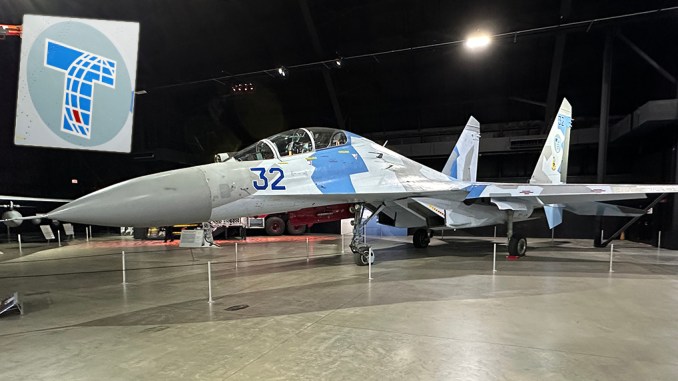
There’s an interesting, almost forgotten detail in the history of the mysterious ex-Ukrainian Air Force Su-27 that you can find on display at NMUSAF in Dayton, Ohio: it was brought to the U.S. to find oil and gas.
The former Ukrainian Air Force Su-27UB Flanker C “61 Blue” (c/n 96310408027, f/n 05-02, built on Mar. 30 1988), now carrying civilian registration N132SU/”32 blue”, recently acquired by the National Museum of the U.S. Air Force, was not brought to the U.S. to be used in the aggressor role. At least, not initially.
Along with the another two-seat Su-27 (N131SU/31 blue), the ex-UkrAF Flanker eventually made its way to the adversary air services but, at least officially, they were originally meant to undertake a completely different role: both jets were procured to be used in a scheme to find oil and gas. Something that has been known for quite some time but has also been forgotten in reporting the history of the aircraft.
The two aircraft, were in fact bought from the Ukrainian Government by a company called Terralliance Technologies, that operated in the oil exploration business between 2004 and 2009: the logo of this company (a large “T”) can still be seen on the tail of the Su-27 “32 blue”.
The Su-27UB on display in the Cold War Gallery of the museum at Wright-Patterson Air Force Base. (Image credit: Tom Demerly/TheAviationist.com)
” data-medium-file=”https://i0.wp.com/theaviationist.com/wp-content/uploads/2023/12/Su-27-oil-exploration-background.jpeg?fit=460%2C257&ssl=1″ data-large-file=”https://i0.wp.com/theaviationist.com/wp-content/uploads/2023/12/Su-27-oil-exploration-background.jpeg?fit=706%2C394&ssl=1″ decoding=”async” class=”size-large wp-image-84511″ src=”https://zephyrnet.com/wp-content/uploads/2023/12/su-27-flanker-on-display-at-the-usaf-museum-originally-imported-to-be-used-for-oil-exploration-1.jpg” alt=”Su-27 NMUSAF” width=”706″ height=”394″ srcset=”https://zephyrnet.com/wp-content/uploads/2023/12/su-27-flanker-on-display-at-the-usaf-museum-originally-imported-to-be-used-for-oil-exploration-1.jpg 706w, https://zephyrnet.com/wp-content/uploads/2023/12/su-27-flanker-on-display-at-the-usaf-museum-originally-imported-to-be-used-for-oil-exploration-4.jpg 460w, https://zephyrnet.com/wp-content/uploads/2023/12/su-27-flanker-on-display-at-the-usaf-museum-originally-imported-to-be-used-for-oil-exploration-5.jpg 128w, https://zephyrnet.com/wp-content/uploads/2023/12/su-27-flanker-on-display-at-the-usaf-museum-originally-imported-to-be-used-for-oil-exploration-6.jpg 768w, https://i0.wp.com/theaviationist.com/wp-content/uploads/2023/12/Su-27-oil-exploration-background.jpeg?w=1024&ssl=1 1024w” sizes=”(max-width: 706px) 100vw, 706px” data-recalc-dims=”1″>
Around 2004, Terralliance Technologies’s founder and former NASA engineer Erlend Olson, was looking for innovative ways to find oil fields. At a certain point, the company claimed to have exploration rights or being in the process of negotiating rights to explore across 4 different continents including 8 African countries. “Olson decided that Terralliance needed to make its own maps rather than rely on purchased satellite data. So the company bought an airplane and a helicopter, each fitted with custom-designed sensors,” says a CNN story published back in 2010 (that you can still find an archived version here).
“For Olson, this “low and slow” approach was a half-measure. He craved the “high and fast” capability of U-2 spy planes that NASA uses for research.”
Needless to say, U-2s weren’t available for commercial use, therefore, Olson had to buy something else: the two Ukrainian Su-27 Flankers. The intention was for the two fighters to carry a pod with remote-sensing technology and scan large areas in search for oil. It’s not clear whether the plan was to deploy the aircraft abroad or use them only over the U.S., anyway, Terralliance paid 22 million USD for the pair of jets, as well as more than 4 million USD for an option to purchase two others according to the CNN article.
Terralliance hired Pride Aircraft to disassemble the aircraft, put them back together once in the U.S., install western avionics and make them airworthy again. Meridican Capital LLC provided financing and this is the reason why the aircraft was registered to the company based in Delaware that “offers years of experience in the brokerage and acquisition of specialized military hardware, including aircraft”.
In the end, the Su-27s never flew a mission for Terralliance. The company ran out of money in 2009 and the Flankers were sold to the U.S. Government. One might wonder whether this was just a “scripted ending” and the oil research mission was just a cover-up, however, nothing has emerged so far to support this theory.
Interestingly, the original Terralliance logo on the tails of the Su-27 was covered with the Pride badge when the aircraft carried out the first test flights in 2009, but the original emblem surfaced again when the Museum staff pulled off the Pride stickers recently.
Terralliance logo on the tail of the Su-27 at NMUSAF.
” data-medium-file=”https://i0.wp.com/theaviationist.com/wp-content/uploads/2023/12/Terralliance-logo.jpg?fit=410%2C460&ssl=1″ data-large-file=”https://i0.wp.com/theaviationist.com/wp-content/uploads/2023/12/Terralliance-logo.jpg?fit=706%2C792&ssl=1″ decoding=”async” loading=”lazy” class=”size-large wp-image-84510″ src=”https://zephyrnet.com/wp-content/uploads/2023/12/su-27-flanker-on-display-at-the-usaf-museum-originally-imported-to-be-used-for-oil-exploration-2.jpg” alt width=”706″ height=”792″ srcset=”https://zephyrnet.com/wp-content/uploads/2023/12/su-27-flanker-on-display-at-the-usaf-museum-originally-imported-to-be-used-for-oil-exploration-2.jpg 706w, https://zephyrnet.com/wp-content/uploads/2023/12/su-27-flanker-on-display-at-the-usaf-museum-originally-imported-to-be-used-for-oil-exploration-7.jpg 410w, https://zephyrnet.com/wp-content/uploads/2023/12/su-27-flanker-on-display-at-the-usaf-museum-originally-imported-to-be-used-for-oil-exploration-8.jpg 86w, https://zephyrnet.com/wp-content/uploads/2023/12/su-27-flanker-on-display-at-the-usaf-museum-originally-imported-to-be-used-for-oil-exploration-9.jpg 768w, https://i0.wp.com/theaviationist.com/wp-content/uploads/2023/12/Terralliance-logo.jpg?w=1128&ssl=1 1128w” sizes=”(max-width: 706px) 100vw, 706px” data-recalc-dims=”1″>
The rest of the story is the one we have already described here.
A certificate of airworthiness was issued to Pride by the FAA in December 2009; a second COA was issued for the Su-27 in 2010 to Tactical Air Support, a company that provides contract adversary air services to U.S. military forces.
The aircraft, based at Rockford airport, Illinois, were operated for some years by Tactical Air Support retaining their Ukrainian splinter camouflage, only replacing the “61 Blue” tactical code with a new “32 Blue”.
They were later sold again and continued to operate from Rockford, this time without any involvement in contractor work, until their airworthiness certificates expired in 2013. Both Flankers were then removed from the US register in 2018. What they were used for until the National Museum of the U.S. Air Force managed to acquire “32 Blue” is not clear. Someone believes the TacAir continued to operate the Su-27 for adversary services or that the Flankers were transferred to the U.S. Air Force to perform similar activities as part of a foreign material exploitation program.
- SEO Powered Content & PR Distribution. Get Amplified Today.
- PlatoData.Network Vertical Generative Ai. Empower Yourself. Access Here.
- PlatoAiStream. Web3 Intelligence. Knowledge Amplified. Access Here.
- PlatoESG. Carbon, CleanTech, Energy, Environment, Solar, Waste Management. Access Here.
- PlatoHealth. Biotech and Clinical Trials Intelligence. Access Here.
- Source: https://theaviationist.com/2023/12/27/su-27-oil-exploration-mission/?utm_source=rss&utm_medium=rss&utm_campaign=su-27-oil-exploration-mission




